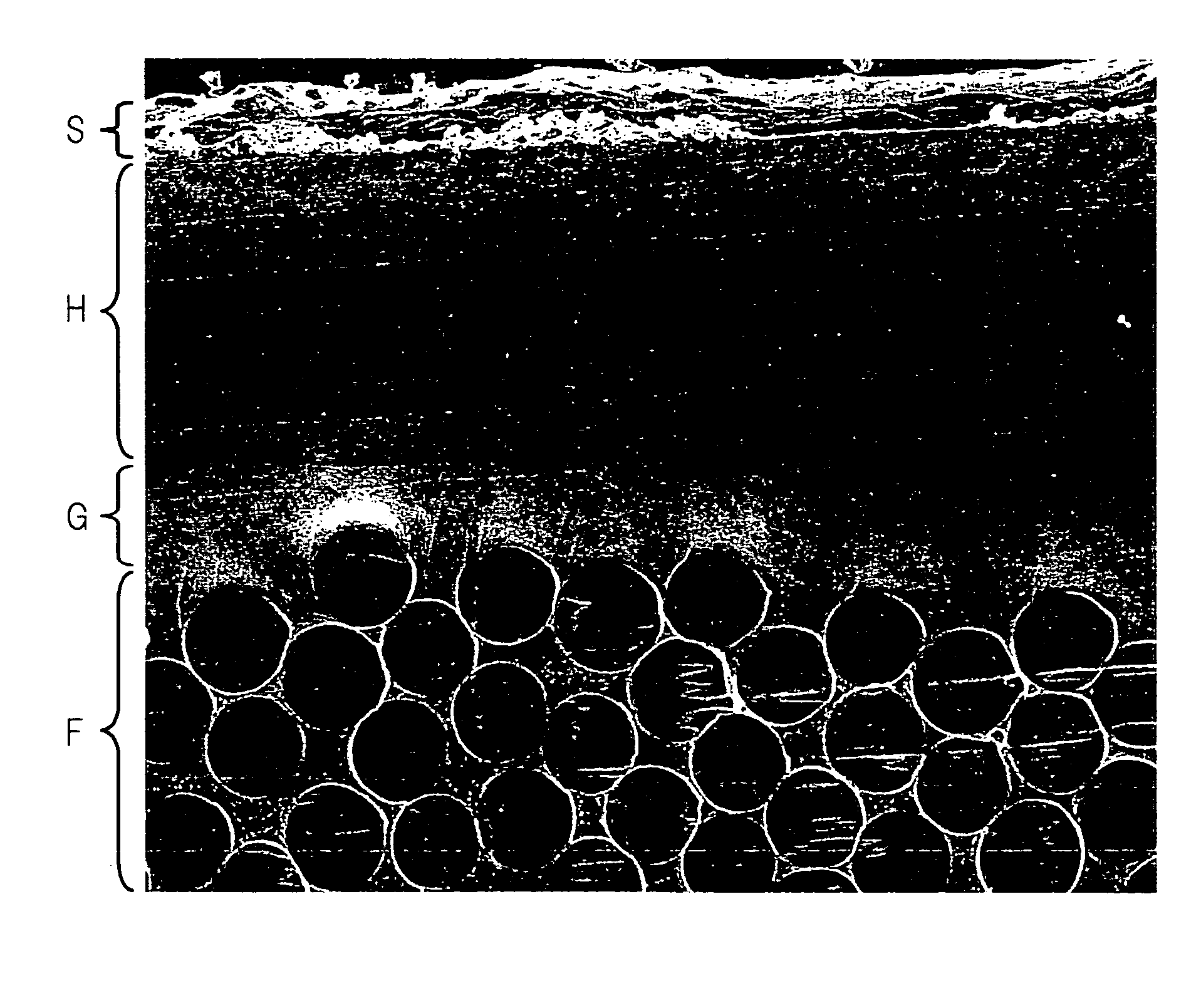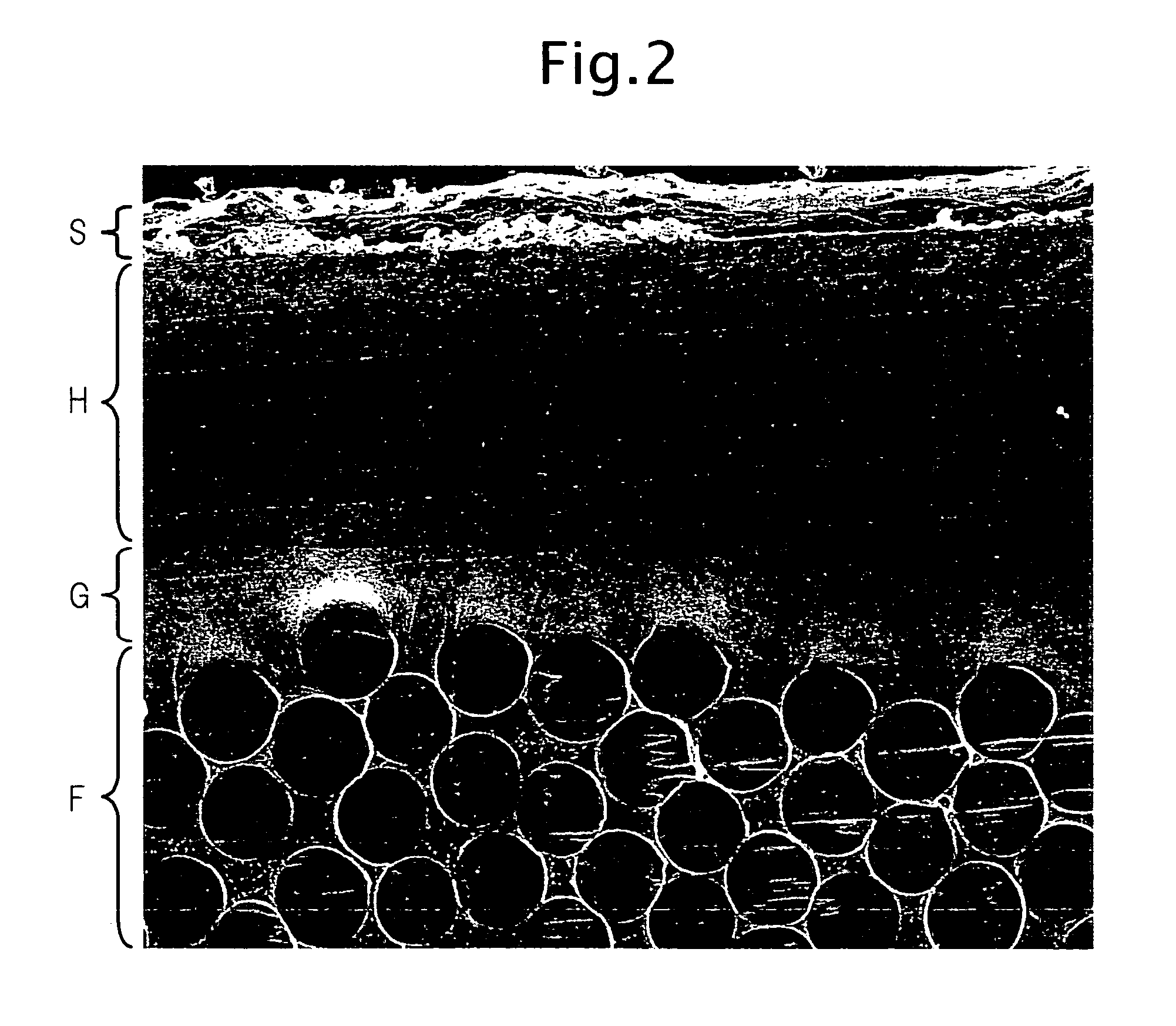Hollow Weave Fabric for an Air Bag and Method of Producing the Same
a technology of weave fabric and air bag, which is applied in the directions of weaving, pedestrian/occupant safety arrangement, vehicular safety arrangement, etc., can solve the problems of air bag weight increase, air bag has no internal pressure retaining function, and long and large air bag, etc., to achieve excellent internal pressure retention and light weight
- Summary
- Abstract
- Description
- Claims
- Application Information
AI Technical Summary
Benefits of technology
Problems solved by technology
Method used
Image
Examples
example 1
[0200] A nylon 66 fiber having a total size of 235 dtex and a single filament size of 3.3 dtex was used as a warp yarn and a weft yarn, and a gray fabric having a design as shown in FIG. 1 was prepared with an electronic jacquard apparatus and a rapier loom. The gray fabric was then scoured and set. The seam zone formed a reversible figured weave when seen from the bag portion side. A double-layer hollow weave portion was then prepared from two yarns. Moreover, a 2 / 2 basket weave pattern was formed as a single-layer portion out of 6 yarns.
[0201] Next, the fabric was coated with a liquid silicone composition in an amount of 50 g / m2 on one side using a roll-on-knife coater, and heat treated at 180° C. for 1 minute in a drying machine. The fabric was similarly coated with a liquid silicone composition in an amount of 50 g / m2 on the other side, and heat treated at 180° C. for 1 minute in a drying machine. The bag portion after coating had a warp yarn density of 72 ends / 2.54 cm and a we...
example 2
[0207] The fabric obtained in the same manner as in Example 1 was coated with a liquid silicone composition in an amount of 50 g / m2 on one side using a roll-on-knife coater, and heat treated at 180° C. for 1 minute in a drying machine. The fabric was similarly coated with a liquid silicone composition in an amount of 50 g / m2 on the other side, and heat treated at 180° C. for 1 minute in a drying machine. The bag portion after coating had a warp yarn density of 72 ends / 2.54 cm and a weft yarn density of 72 picks / 2.54 cm.
[0208] An air bag was prepared from the hollow weave fabric for an air bag thus obtained. The properties of the air bag were as shown in Table 1. The air bag was excellent in compactness, and showed good internal pressure retention, and quick deployment speed.
[0209] The liquid silicone composition used herein was produced as explained below.
[0210] (1) Hexamethyldisilazane-treated silica in an amount of 11 parts by weight and 33 parts by weight of a vinyl-terminated...
example 3
[0222] A nylon 66 fiber having a total size of 175 dtex and a single filament size of 3.1 dtex was used as a warp yarn and a weft yarn, and a gray fabric having a design as shown in FIG. 1 was prepared with an electronic jacquard apparatus and a rapier loom. The gray fabric was then subjected to a set-coat step to give a double-layer hollow weave textured fabric having a warp yarn density of 166 ends / 2.54 cm and a weft yarn density of 166 / 2.54 cm. The seam zone formed a reversible figured weave when seen from the bag portion side. A double-layer hollow weave portion was then prepared from two yarns. Moreover, a 2 / 2 basket weave pattern was formed as a single-layer portion out of 8 yarns.
[0223] Next, the fabric was coated with a liquid silicone composition in an amount of 35 g / m2 on one side using a roll-on-knife coater, and heat treated at 180° C. for 1 minute in a drying machine. The fabric was similarly coated with a liquid silicone composition in an amount of 35 g / m2 on the othe...
PUM
| Property | Measurement | Unit |
|---|---|---|
| viscosity | aaaaa | aaaaa |
| tensile elongation | aaaaa | aaaaa |
| viscosity | aaaaa | aaaaa |
Abstract
Description
Claims
Application Information
 Login to View More
Login to View More - R&D
- Intellectual Property
- Life Sciences
- Materials
- Tech Scout
- Unparalleled Data Quality
- Higher Quality Content
- 60% Fewer Hallucinations
Browse by: Latest US Patents, China's latest patents, Technical Efficacy Thesaurus, Application Domain, Technology Topic, Popular Technical Reports.
© 2025 PatSnap. All rights reserved.Legal|Privacy policy|Modern Slavery Act Transparency Statement|Sitemap|About US| Contact US: help@patsnap.com



